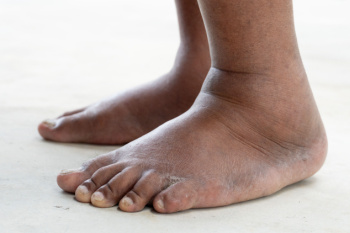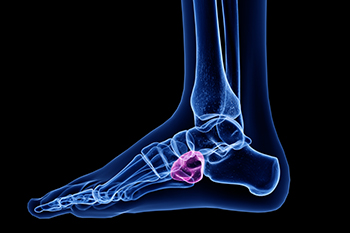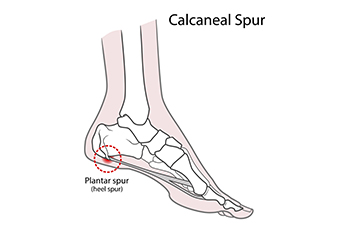Items filtered by date: December 2024
Common Causes of Swollen Ankles and Effective Relief Methods

Swollen ankles are a common issue that can arise from various causes, including poor circulation, injury, or fluid retention. Conditions such as heart, kidney, or liver disease can lead to fluid buildup in the lower extremities, causing swelling. Prolonged standing or sitting, especially during long flights or road trips, can also contribute to ankle swelling. Injury, such as sprains or fractures, often results in swelling as the body reacts to trauma. To relieve swollen ankles, elevating the feet can help reduce fluid accumulation. Applying cold compresses can reduce swelling and provide pain relief. Wearing compression socks and staying active by walking or moving the feet regularly can improve circulation. Reducing salt intake and staying hydrated also helps prevent fluid retention. If you have swollen feet and ankles, it is suggested that you consult a podiatrist who can determine what the cause is, and offer appropriate relief and management solutions.
Swollen feet can be a sign of an underlying condition. If you have any concerns, contact one of our podiatrists of Pocono Foot & Ankle Consultants. our doctors can provide the care you need to keep you pain-free and on your feet.
Swollen feet are a common ailment among pregnant women and people who stand or sit for extended periods. Aging may increase the possibility of swollen feet and patients who are obese often notice when their feet are swelling too. There may be medical reasons why swollen feet occur:
- Phlebitis - A condition that causes the veins to become inflamed and can also cause leg pain.
- Liver disease - This may lead to low blood levels of albumin which is a protein. This can cause fluid in the blood to pass into the tissues and several areas of the body can become swollen.
- Heart failure - When the heart doesn’t pump properly the blood that is normally pumped back to the heart can pool in the veins of the legs causing swollen feet.
- Kidney disease - One of the main functions of the kidneys is releasing excess fluid in the body. This type of condition can make it difficult for the kidneys to function properly, and as a result the feet may become swollen.
- Deep-vein thrombosis (DVT)- This is a serious condition where blood clots form in the veins of the legs. They can block the return of blood from the legs to the heart which may cause the feet to swell. It is important to be treated by a podiatrist if this condition is present.
Swollen feet can also be caused by bone and tendon conditions, including fractures, arthritis, and tendinitis. Additionally, there may be skin and toenail conditions and an infection may cause the feet to swell. Patients who take medicine to treat high blood pressure may be prone to getting swollen feet.
Many patients elevate their feet to help relieve the swelling and this is generally a temporary remedy. When a podiatrist is consulted the reason behind the swelling can be uncovered and subsequently treated.
If you have any questions please feel free to contact our offices located in Stroudsburg, Nazareth, and Easton, PA . We offer the newest diagnostic tools and technology to treat your foot and ankle needs.
Managing Ankle Pain From Skiing

Skiing can place significant strain on the ankles, often leading to soreness or pain, particularly for those unaccustomed to the activity or wearing poorly fitting boots. The repetitive flexing and rotational demands of skiing can stress the ankle joints, ligaments, and supporting muscles. Ankle pain from skiing may result from overuse, improper alignment in ski boots, or injuries such as sprains or strains. Pain often affects the tendons and muscles that stabilize the joint, sometimes accompanied by swelling or difficulty bearing weight. A podiatrist can assess your ankle pain to determine its cause, whether it stems from biomechanical issues, improper equipment, or soft tissue injury. Treatment may involve improving joint stability, recommending supportive footwear, or addressing specific conditions to reduce pain and prevent further complications. If you experience ankle pain after skiing, it is suggested that you schedule an appointment with a podiatrist for an exam and treatment options.
Sports related foot and ankle injuries require proper treatment before players can go back to their regular routines. For more information, contact one of our podiatrists of Pocono Foot & Ankle Consultants. our doctors can provide the care you need to keep you pain-free and on your feet.
Sports Related Foot and Ankle Injuries
Foot and ankle injuries are a common occurrence when it comes to athletes of any sport. While many athletes dismiss the initial aches and pains, the truth is that ignoring potential foot and ankle injuries can lead to serious problems. As athletes continue to place pressure and strain the area further, a mild injury can turn into something as serious as a rupture and may lead to a permanent disability. There are many factors that contribute to sports related foot and ankle injuries, which include failure to warm up properly, not providing support or wearing bad footwear. Common injuries and conditions athletes face, including:
- Plantar Fasciitis
- Plantar Fasciosis
- Achilles Tendinitis
- Achilles Tendon Rupture
- Ankle Sprains
Sports related injuries are commonly treated using the RICE method. This includes rest, applying ice to the injured area, compression and elevating the ankle. More serious sprains and injuries may require surgery, which could include arthroscopic and reconstructive surgery. Rehabilitation and therapy may also be required in order to get any recovering athlete to become fully functional again. Any unusual aches and pains an athlete sustains must be evaluated by a licensed, reputable medical professional.
If you have any questions please feel free to contact our offices located in Stroudsburg, Nazareth, and Easton, PA . We offer the newest diagnostic and treatment technologies for all your foot and ankle needs.
Symptoms and Diagnosis of Broken Ankles

A broken ankle occurs when one or more bones in the joint crack or break due to trauma, such as a fall, sports injury, or car accident. Symptoms typically include severe pain, swelling, bruising, and difficulty walking or bearing weight. The ankle may look deformed or feel unstable, depending on the severity of the break. A podiatrist diagnoses a broken ankle through a physical exam and imaging tests like X-rays or CT scans to determine the exact location and how serious the fracture is. Treatment varies based on the type of break. Minor fractures may only require a cast or boot to immobilize the ankle, while more severe breaks could need surgery to realign and stabilize the bones with screws or plates. If you suspect you have an ankle fracture, it is suggested that you promptly see a podiatrist to ensure proper healing and recovery.
Broken ankles need immediate treatment. If you are seeking treatment, contact one of our podiatrists from Pocono Foot & Ankle Consultants. our doctors can provide the care you need to keep you pain-free and on your feet.
Broken Ankles
A broken ankle is experienced when a person fractures their tibia or fibula in the lower leg and ankle area. Both of these bones are attached at the bottom of the leg and combine to form what we know to be our ankle.
When a physician is referring to a break of the ankle, he or she is usually referring to a break in the area where the tibia and fibula are joined to create our ankle joint. Ankles are more prone to fractures because the ankle is an area that suffers a lot of pressure and stress. There are some obvious signs when a person experiences a fractured ankle, and the following symptoms may be present.
Symptoms of a Fractured Ankle
- Excessive pain when the area is touched or when any pressure is placed on the ankle
- Swelling around the area
- Bruising of the area
- Area appears to be deformed
If you suspect an ankle fracture, it is recommended to seek treatment as soon as possible. The sooner you have your podiatrist diagnose the fracture, the quicker you’ll be on the way towards recovery.
If you have any questions, please feel free to contact our offices located in Stroudsburg, Nazareth, and Easton, PA . We offer the newest diagnostic and treatment technologies for all your foot care needs.
Inspect Your Feet Regularly for Abnormalities if You're Diabetic
How Cuboid Syndrome Is Diagnosed

Cuboid syndrome is a condition that affects the foot, specifically the cuboid bone, which is one of the seven tarsal bones located on the outer side of the foot. This syndrome occurs when the cuboid bone becomes slightly misaligned or stiff, often leading to pain in the outer part of the foot. The main causes of cuboid syndrome include sudden movements, foot injuries, overuse, or wearing improper footwear. Activities such as running, jumping, or twisting can strain the cuboid bone and surrounding tissues. Common symptoms include localized pain, swelling, and tenderness on the outer foot, in addition to difficulty walking or bearing weight. To diagnose cuboid syndrome, a podiatrist typically conducts a physical examination and may perform specific manipulation tests. In some cases, imaging tests like X-rays or MRI scans may be used to rule out other conditions and confirm the diagnosis. If you have pain in the outer part of your foot, it is suggested that you consult a podiatrist who can accurately diagnose and treat the problem.
Cuboid syndrome, also known as cuboid subluxation, occurs when the joints and ligaments near the cuboid bone in the foot become torn. If you have cuboid syndrome, consult with one of our podiatrists from Pocono Foot & Ankle Consultants. our doctors will assess your condition and provide you with quality foot and ankle treatment.
Cuboid syndrome is a common cause of lateral foot pain, which is pain on the outside of the foot. The condition may happen suddenly due to an ankle sprain, or it may develop slowly overtime from repetitive tension through the bone and surrounding structures.
Causes
The most common causes of cuboid syndrome include:
- Injury – The most common cause of this ailment is an ankle sprain.
- Repetitive Strain – Tension placed through the peroneus longus muscle from repetitive activities such as jumping and running may cause excessive traction on the bone causing it to sublux.
- Altered Foot Biomechanics – Most people suffering from cuboid subluxation have flat feet.
Symptoms
A common symptom of cuboid syndrome is pain along the outside of the foot which can be felt in the ankle and toes. This pain may create walking difficulties and may cause those with the condition to walk with a limp.
Diagnosis
Diagnosis of cuboid syndrome is often difficult, and it is often misdiagnosed. X-rays, MRIs and CT scans often fail to properly show the cuboid subluxation. Although there isn’t a specific test used to diagnose cuboid syndrome, your podiatrist will usually check if pain is felt while pressing firmly on the cuboid bone of your foot.
Treatment
Just as the range of causes varies widely, so do treatments. Some more common treatments are ice therapy, rest, exercise, taping, and orthotics.
If you have any questions, please feel free to contact our offices located in Stroudsburg, Nazareth, and Easton, PA . We offer the newest diagnostic and treatment technologies for all your foot care needs.
Bone Spurs on the Feet

Bone spurs on the feet are bony growths that form along joints, commonly in the heel. Repetitive pressure causes the body to produce extra bone tissue, forming spurs as a protective response. Symptoms may include sharp or aching pain, swelling, or tenderness, especially when walking or standing for long periods. People at higher risk include those with flat feet, high arches, or jobs that require prolonged standing. A podiatrist diagnoses bone spurs through a physical examination and imaging, such as X-rays. Treatment often involves anti-inflammatory medications, orthotic inserts, stretching exercises, or, in severe cases, surgery to remove the spurs. If you have heel pain, it is suggested that you schedule an appointment with a podiatrist who can diagnose the cause, help you manage symptoms, and prevent further discomfort.
Heel spurs can be incredibly painful and sometimes may make you unable to participate in physical activities. To get medical care for your heel spurs, contact one of our podiatrists from Pocono Foot & Ankle Consultants. our doctors will do everything possible to treat your condition.
Heels Spurs
Heel spurs are formed by calcium deposits on the back of the foot where the heel is. This can also be caused by small fragments of bone breaking off one section of the foot, attaching onto the back of the foot. Heel spurs can also be bone growth on the back of the foot and may grow in the direction of the arch of the foot.
Older individuals usually suffer from heel spurs and pain sometimes intensifies with age. One of the main condition's spurs are related to is plantar fasciitis.
Pain
The pain associated with spurs is often because of weight placed on the feet. When someone is walking, their entire weight is concentrated on the feet. Bone spurs then have the tendency to affect other bones and tissues around the foot. As the pain continues, the feet will become tender and sensitive over time.
Treatments
There are many ways to treat heel spurs. If one is suffering from heel spurs in conjunction with pain, there are several methods for healing. Medication, surgery, and herbal care are some options.
If you have any questions feel free to contact our offices located in Stroudsburg, Nazareth, and Easton, PA . We offer the latest in diagnostic and treatment technology to meet your needs.

